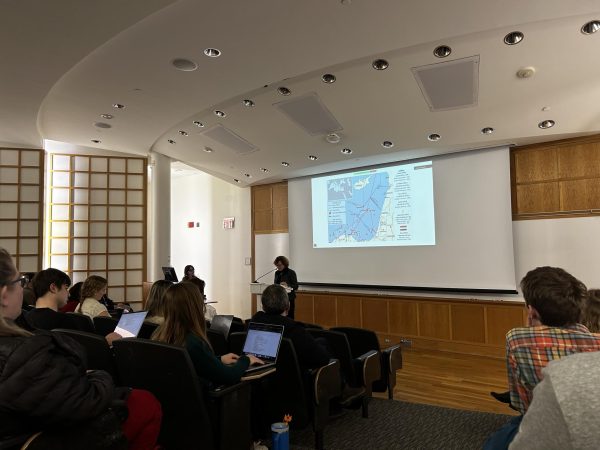Neuroscience Senior Theses
Olin Hall may be closed for renovation, but that has not stopped the important work of Colgate’s neuroscience concentrators. Seniors are conducting research and reporting findings in various areas of the scientific field in their senior theses.
Senior Eva Wiener’s thesis concerns neuromasts (cell clusters) along the zebrafish lateral line, an organ used to detect water movement that provides the fish the ability to orient themselves among their surroundings. Her research is advised by Jason Meyers, associate professor of biology and neuroscience.
“The reason that we study these cells is that neuromasts have hair cells in them, and we also have hair cells in our ears that are used for similar things,” Wiener explained. “When we lose our hair cells over time because of age or sound damage or various kinds of damage to the ear, we don’t get them back, and that leads to permanent hearing loss.”
Wiener further added that zebrafish have a regenerative process that allows their hair cells to grow back, unlike humans.
“It’s a way for fish to continually have hair cells in their inner ear and throughout their lateral line,” Wiener said.
Wiener’s experiments required waiting for the maturation of zebrafish which extended the time required to conduct in-lab research.
“Most of what you’re doing in a thesis is actually just the experiments — they are so time-consuming,” Wiener said. “From beginning to end, I would say the fastest I can do an experiment is a week and a half.”
Senior Sarah Hiranandani studied the ability of crickets to compensate for a lack of certain nutrients in their food. The research builds on that of her faculty advisor, professor of psychology and neuroscience Ann Jane Tierney, who has researched crickets’ ability to sense a lack of amino acids in their foods.
“Amino acids are the precursor for making proteins, which are obviously really important to us humans, but also to every animal,” Hiranandani explained. “What [Tierney] looked at was how crickets were able to be deprived of certain amino acids and then were able to seek those amino acids out in food later on.”
Hiranandani’s research specifically looked at how crickets were able to sense specific amino acids in their food sources. Hiranandani worked with seniors Lauryn Johnson, Meghan Pauly and Maya Souvignier in the completion of the group thesis project.
“We were looking at how, if we deprived crickets of specifically tryptophan [a precursor for serotonin] and just that one amino acid, whether or not they were able to sense that deprivation,” Hiranandani said.
Hiranandani commented on the challenges posed by the ongoing construction at Olin Hall on her chosen topic for her senior thesis. She also expressed her appreciation for continuing the research work of her advisor.
“With all the work being done on Olin there wasn’t really an option for us to have separate projects, and so we were continuing the work that our professor did,” Hiranandani said. “I feel like at first we kind of thought that maybe this is a downside that we don’t get to decide exactly what we want to do […] but it made it so that we all have to work together and get to work on something that our professor is an expert in.”
Senior Peyton Lee’s senior thesis looks at the reward system, specifically at a pathway that involves dopamine-producing neuron signals when receiving primary rewards such as food and drugs. Lee is looking primarily at acetylcholine signals sent to the dopamine neurons when receiving a primary reward.
Lee’s research is advised by Professor Ewa Galaj, assistant professor of psychology and neuroscience, who has developed the model of the reward system used in Lee’s research. Lee noted her appreciation of the neurobiological model in helping the writing process of her thesis.
“The project that I’m working with already has a set neurobiological model for what is happening with the primary reward signal, and also with it the associated condition stimulus signal that is sent with it,” Lee said. “I’m working on a small piece of this larger neurobiological model of the reward system, so in that way it is kind of easier to look at what previous work has been done and integrate what I am doing into that.”
Lee’s laboratory experience includes cryostat sectioning, in situ mRNA hybridization protocols and imaging. The laboratory component would have included working with the live rats in person if it were not for Olin Hall being closed for construction, according to Lee.
The research conducted by neuroscience concentrators helps us better understand the workings of the nervous system. The previous work of faculty is useful in helping students build their research and complete their theses as contributing members to neuroscience studies.

Sydney Henderson is a senior from Whitesboro, NY concentrating in economics. She has previously served as a staff writer for the news section. On campus,...










